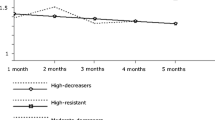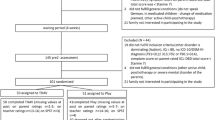Abstract
We examined two emergent processes in treatment (parent-therapist alliance and perceived barriers to treatment participation) in parent management training for children (N = 234, 55 girls and 179 boys, ages 4–14) referred clinically for oppositional, aggressive, and antisocial behavior. We predicted that two parent characteristics (interpersonal relationships and quality of daily life) evaluated prior to treatment would predict quality of the therapeutic alliance and perceived barriers during treatment. Alliance and perceived barriers were significantly related to treatment outcome. Stronger alliance and fewer perceived barriers were associated with greater therapeutic change. Interpersonal relationships and quality of daily life, each represented with multiple measures, predicted quality of the therapeutic alliance and perceived barriers during treatment. Alliance and barriers continued to predict therapeutic change even after controlling for pretreatment predictors of these emergent processes.
Similar content being viewed by others
References
Abidin, R. R. (1995). Parenting Stress Index: manual (3rd ed.). Odessa, FL: Psychological Assessment Resources.
American Psychiatric Association (1994). Diagnostic and statistical manual of mental disorders (4th ed.). Washington, DC: Author.
American Psychiatric Association (2000). Diagnostic and statistical manual of mental disorders (DSM-IV-TR). Washington, DC: American Psychiatric Association.
American Psychological Association (2015). Stress in America: Paying with our health. Washington, DC: American Psychological Association.
Aneshensel, C. S., & Stone, J. D. (1982). Stress and depression: A test of the buffering model of social support. Archives of General Psychiatry, 39, 1392–1396.
Busby, D. M., Christensen, C., Crane, D. R., & Larson, J. H. (1995). A revision of the Dyadic Adjustment Scale for use with distressed and nondistressed couples: Construct hierarchy and multidimensional scales. Journal of Marital and Family Therapy, 21(3), 289–308.
Caughter, S., & Dunsmuir, S. (2017). An exploration of the mechanisms of change following an integrated group intervention for stuttering, as perceived by school-aged children who stutter (CWS). Journal of Fluency Disorders, 51, 8–23.
Crits-Christoph, P., Gibbons, M. B. C., & Mukherjee, D. (2013). Psychotherapy process outcome research. In M. J. Lambert (Ed.), Bergin and Garfield’s handbook of psychotherapy and behavior change (6th ed.). (pp. 298–339). New York: Wiley.
De Los Reyes, A., Aldao, A., & Augenstein, T. M. (2017). Assessment issues in child and adolescent psychotherapy. In J. R. Weisz & A. E. Kazdin (Eds.), Evidence-based psychotherapies for children and adolescents (3rd ed.). (pp. 537–554). New York: Guilford Press.
Dew, S. E., & Bickman, L. (2005). Client expectancies about therapy. Mental Health Services Research, 7(1), 21–33.
Dolbier, C. L., & Steinhardt, M. A. (2000). The development and validation of the sense of support scale. Behavioral Medicine, 25, 169–179.
Eddy, J. M., & Chamberlain, P. (2000). Family management and deviant peer association as mediators of the impact of treatment condition on youth antisocial behavior. Journal of Consulting and Clinical Psychology, 68, 857–863.
Forgatch, M. S., & DeGarmo, D. S. (1999). Parenting through change: an effective prevention program for single mothers. Journal of Consulting and Clinical Psychology, 67(5), 711–724.
Foster, S. L., & Robin, A. L. (1997). Family conflict and communication in adolescence. In E. J. Mash & L. G. Terdal (Eds.), Assessment of childhood disorders (3rd ed.). (pp. 627–682). New York: Guilford.
Frisch, M. B. (2014). Quality-of-life-inventory. In R. A. Cummins & A. C. Michalos (Eds.), Encyclopedia of quality of life and well-being research. (pp. 5374–5377). Netherlands: Springer
Frisch, M. B., Clark, M. P., Rouse, S. V., Rudd, M. D., Paweleck, J. K., Greenstone, A., & Kopplin, D. A. (2005). Predictive and treatment validity of life satisfaction and the quality of life inventory. Assessment 12(1), 66–78.
Henderson, C. E., Rowe, C. L., Dakof, G. A., Hawes, S. W., & Liddle, H. A. (2009). Parenting practices as mediators of treatment effects in an early-intervention trial of multidimensional family therapy. American Journal of Drug and Alcohol Abuse, 35(4), 220–226.
Horvath, A. O., & Bedi, R. P. (2002). The alliance. In J. C. Norcross (Ed.), Psychotherapy relationships that work: Therapist contributions and responsiveness to patients (pp. 37–69). New York: Oxford University Press.
Horvath, A. O., Del Re, A. C., Flückiger, C., & Symonds, D. (2011). Alliance in individual psychotherapy. Psychotherapy, 48, 9–16.
Horvath, A. O., & Greenberg, L. S. (1989). Development and validation of the working alliance inventory. Journal of Counseling Psychology, 36, 223–233.
Karver, M. S., Handelsman, J. B., Fields, S., & Bickman, L. (2005). A theoretical model of common process factors in youth and family therapy. Mental Health Services Research, 7, 35–52.
Karver, M. S., Handelsman, J. B., Fields, S., & Bickman, L. (2006). Meta-analysis of therapeutic relationship variables in youth and family therapy: the evidence for different relationship variables in the child and adolescent treatment outcome literature. Clinical Psychology Review, 26, 50–65.
Kazdin, A. E. (2000). Perceived barriers to treatment participation and treatment acceptability among antisocial children and their families. Journal of Child and Family Studies, 9, 157–174.
Kazdin, A. E. (2009). Parent management training: Treatment for oppositional, aggressive, and antisocial behavior in children and adolescents. New York: Oxford University Press.
Kazdin, A. E. (2014). Moderators, mediators, and mechanisms of change in psychotherapy. In W. Lutz & S. Knox (Eds.), Quantitative and qualitative methods in psychotherapy (pp. 87–101). East Sussex: Routledge.
Kazdin, A. E. (2015). Psychosocial treatments for conduct disorder in children a nd adolescents. In P. E. Nathan, J. M. Gorman (eds.) A guide to treatments that work (4th ed.). (pp. 141–173). New York: Oxford University Press. .
Kazdin, A. E. (2017a). Parent management training and problem-solving skills training for child and adolescent conduct problems. In J. R. Weisz & A. E. Kazdin (Eds.), Evidence-based psychotherapies for children and adolescents. (3rd ed.). (pp. 142–158). New York: Guilford Press.
Kazdin, A. E. (2017b). Research design in clinical psychology (5th ed.). Boston, MA: Pearson.
Kazdin, A. E., Bass, D., Ayers, W. A., & Rodgers, A. (1990). The empirical and clinical focus of child and adolescent psychotherapy research. Journal of Consulting and Clinical Psychology, 58, 729–740.
Kazdin, A. E., & Durbin, K. A. (2012). Predictors of child-therapist alliance in cognitive-behavioral treatment of children referred for oppositional and antisocial behavior. Psychotherapy, 49, 202–217.
Kazdin, A. E., Holland, L., & Crowley, M. (1997a). Family experience of barriers to treatment and premature termination from child therapy. Journal of Consulting and Clinical Psychology, 65, 453–463.
Kazdin, A. E., Holland, L., Crowley, M., & Breton, S. (1997b). Barriers to participation in treatment scale: evaluation and validation in the context of child outpatient treatment. Journal of Child Psychology and Psychiatry, 38, 1051–1062.
Kazdin, A. E., Marciano, P. L., & Whitley, M. (2005). The therapeutic alliance in cognitive-behavioral treatment of children referred for oppositional, aggressive, and antisocial behavior. Journal of Consulting and Clinical Psychology, 73, 726–730.
Kazdin, A. E., Siegel, T., & Bass, D. (1992). Cognitive problem-solving skills training and parent management training in the treatment of antisocial behavior in children. Journal of Consulting and Clinical Psychology, 60, 733–747.
Kazdin, A. E., & Wassell, G. (2000). Predictors of barriers to treatment and therapeutic change in outpatient therapy for antisocial children and their families. Mental Health Services Research, 2, 27–40.
Kazdin, A. E., & Whitley, M. K. (2006). Pretreatment social relations, therapeutic alliance, and improvements in parenting practices in parent management training. Journal of Consulting and Clinical Psychology, 74, 346–355.
Kazdin, A. E., Whitley, M., & Marciano, P. L. (2006). Child-therapist and parent-therapist alliance and therapeutic change in the treatment of children referred for oppositional, aggressive, and antisocial behavior. Journal of Child Psychology and Psychiatry, 47, 436–445.
Kurdek, L. A. (1992). Dimensionality of the dyadic adjustment scale: evidence from heterosexual and homosexual couples. Journal of Family Psychology, 6(1), 22–35.
Lloyd, B. H., & Abidin, R. R. (1985). Revision of the parenting stress index. Journal of Pediatric Psychology, 10, 169–177.
Mischel, W., & Shoda, Y. (1995). A cognitive-affective system theory of personality: Reconceptualizing situations, dispositions, dynamics, and invariance in personality structure. Psychological Review, 102, 246–268.
Moos, R. H., & Moos, B. S. (1981). Family Environment Scale manual. Palo Alto, CA: Consulting Psychologists Press.
Norcross, J. C. (Ed.) (2011). Psychotherapy relationships that work: Evidence-based responsiveness (2nd ed.). New York: Oxford University Press.
Orlinsky, D. E., Rønnestad, M. H., & Willutzki, U. (2004). Fifty years of psychotherapy process-outcome research: continuity and change. In M. J. Lambert (Ed.), Bergin and Garfield’s handbook of psychotherapy and behavior change (5th ed.). (pp. 307–389). New York: Wiley.
Rabbitt, S. M., Carrubba, E., Lecza, B., McWhinney, E., Pope, J., & Kazdin, A. E. (2016). Reducing therapist contact in parenting programs: evaluation of internet-based treatments for child conduct problems. Journal of Child and Family Studies, 25(6), 2001–2020.
Shirk, S. R., & Karver, M. S. (2003). Prediction of treatment outcome from relationship variables in child and adolescent therapy: a meta-analytic review. Journal of Consulting and Clinical Psychology, 71, 452–464.
Shirk, S. R., Karver, M. S., & Brown, R. (2011). The alliance in child and adolescent psychotherapy. Psychotherapy, 48, 17–24.
Spanier, G. B., & Thompson, L. (1982). A confirmatory analysis of the dyadic adjustment scale. Journal of Marriage and the Family, 44, 731–738.
Zilcha-Mano, S. (2017). Is the alliance really therapeutic? Revisiting this question in light of recent methodological advances. American Psychologist, 72(4), 311–325.
Zilcha-Mano, S., & Errázuriz, P. (2017). Early development of mechanisms of change as a predictor of subsequent change and treatment outcome: the case of working alliance. Journal of Consulting and Clinical Psychology, 85(5), 508–520.
Acknowledgements
This work was supported in part by MH59029 from the National Institute of Mental Health and by Yale University.
Author information
Authors and Affiliations
Corresponding author
Ethics declarations
Conflict of Interest
Alan Kazdin has received a research grant from NIMH for this work. The authors declare that they have no competing interests.
Rights and permissions
About this article
Cite this article
Kazdin, A.E., McWhinney, E. Therapeutic Alliance, Perceived Treatment Barriers, and Therapeutic Change in the Treatment of Children with Conduct Problems. J Child Fam Stud 27, 240–252 (2018). https://doi.org/10.1007/s10826-017-0869-3
Published:
Issue Date:
DOI: https://doi.org/10.1007/s10826-017-0869-3




